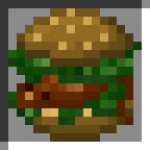Advertisement
Not a member of Pastebin yet?
Sign Up,
it unlocks many cool features!
- -- AR tools API
- --Draws a line from x1,y1 to x2,y2 with given color, using name of wrapped AR controller
- local function drawLineAR(arController,x1,y1,x2,y2,color)
- --color = 0x000000 --Overriding color to black. Comment out to use custom colors
- --arController.addLine({x1,y1},{x2,y2},color,0.5)
- end
- --Basically a line function with cutoffs for anything < 0.
- local function drawHLine(arController,x1,x2,y1,color)
- local width = 0.5
- local border = width*2
- if y1 > border and x1 > border then
- arController.horizontalLine(x1, x2, y1, color)
- end
- end
- --Draws an object with an indexList which points to a list x/y points, using name of wrapped AR controller
- local function drawWireObj(arController,iL,vL,cL) --vL == vertice list. cL == color list
- local vList = {}
- for i = 1, #iL, 3 do --Draws a whole triangle per loop
- if vL.cullFlags[i] >= 0 then --if not marked for culling then render
- local i1,i2 = i+1, i+2
- local col = cL[(i+2)/3]
- drawLineAR(arController, vL[ iL[i] ], vL[ iL[i] +1 ], vL[ iL[i1] ], vL[ iL[i1]+1 ], col) --vert 1 to 2
- drawLineAR(arController, vL[ iL[i1] ], vL[ iL[i1]+1 ], vL[ iL[i2] ], vL[ iL[i2]+1 ], col) --vert 2 to 3
- drawLineAR(arController, vL[ iL[i2] ], vL[ iL[i2]+1 ], vL[ iL[i] ], vL[ iL[i] +1 ], col) --vert 3 to 1
- end
- end
- end
- --Both draw flat top and bottom draw an entire line at a time instead of each pixel individually b/c performance. Will add individual pixel support later.
- local function drawFlatTopTriangle( arController,vec1,vec2,vec3,color )
- --Calculate slopes in screen space
- --Run over rise so we don't get infinite slopes
- local m1 = (vec3.x - vec1.x) / (vec3.y - vec1.y)
- local m2 = (vec3.x - vec2.x) / (vec3.y - vec2.y)
- --Calculate start and end scanlines
- local yStart = math.ceil(vec1.y - 0.5)
- local yEnd = math.ceil(vec3.y - 0.5)-1 --the scanline AFTER the last line drawn
- for y = yStart, yEnd do
- --calculate start and end x's
- --Add 0.5 because we're calculating based on pixel centers
- local px1 = m1 * (y + 0.5 - vec1.y) + vec1.x
- local px2 = m2 * (y + 0.5 - vec2.y) + vec2.x
- --calculate start and end pixelels
- local xStart = math.ceil(px1 - 0.5)
- local xEnd = math.ceil(px2 - 0.5) --the pixel after the last pixel drawn
- for x = xStart, xEnd do
- --drawHLine( arController,xStart,xEnd,y,color )
- arController.addDot({x,y},color,1)
- end
- end
- end
- local function drawFlatBottomTriangle( arController,vec1,vec2,vec3,color )
- --Calculate slopes in screen space
- local m1 = (vec2.x - vec1.x) / (vec2.y - vec1.y)
- local m2 = (vec3.x - vec1.x) / (vec3.y - vec1.y)
- --Calculate start and end scanlines
- local yStart = math.ceil(vec1.y-0.5)
- local yEnd = math.ceil(vec3.y-0.5)-1 --the scanline AFTER the last line drawn, which is why we need to subtract 1 otherwise we get visual bugs
- for y = yStart, yEnd do
- --calculate start and end points (x coords)
- --Add 0.5 because we're calculating based on pixel centers
- local px1 = m1 * (y + 0.5 - vec1.y) + vec1.x
- local px2 = m2 * (y + 0.5 - vec1.y) + vec1.x
- --calculate start and end pixelsh
- local xStart = math.ceil(px1 - 0.5)
- local xEnd = math.ceil(px2 - 0.5)
- for x = xStart, xEnd do
- --drawHLine( arController,xStart,xEnd,y,color )
- arController.addDot({x,y},color,1)
- end
- end
- end
- --Draws a solid triangle from 3 vectors
- local function drawSolidTriangle( arController,vec1,vec2,vec3,color )
- --using pointers so we can swap (for sorting purposes) probably don't need this b/c lua? idk
- local pv1 = vec1
- local pv2 = vec2
- local pv3 = vec3
- --Sort vertices by y
- if pv2.y < pv1.y then pv1,pv2 = pv2,pv1 end
- if pv3.y < pv2.y then pv2,pv3 = pv3,pv2 end
- if pv2.y < pv1.y then pv1,pv2 = pv2,pv1 end
- if pv1.y == pv2.y then --Natural flat top
- --Sort top vertice by x
- if pv2.x < pv1.x then pv1,pv2 = pv2,pv1 end
- drawFlatTopTriangle(arController,pv1,pv2,pv3,color )
- elseif pv2.y == pv3.y then --Natural flat bottom
- --Sort bottom vertice by x
- if pv3.x < pv2.x then pv3,pv2 = pv2,pv3 end
- drawFlatBottomTriangle(arController,pv1,pv2,pv3,color )
- else --General triangle
- local alphaSplit = (pv2.y-pv1.y)/(pv3.y-pv1.y)
- local vi ={
- x = pv1.x + ((pv3.x - pv1.x) * alphaSplit),
- y = pv1.y + ((pv3.y - pv1.y) * alphaSplit), }
- if pv2.x < vi.x then --Major right
- drawFlatBottomTriangle(arController,pv1,pv2,vi,color)
- drawFlatTopTriangle(arController,pv2,vi,pv3,color)
- else --Major left
- drawFlatBottomTriangle(arController,pv1,vi,pv2,color)
- drawFlatTopTriangle(arController,vi,pv2,pv3,color)
- end
- end
- end
- --Draw an entire object one triangle at a time
- --Converts points from the 1D table to vectors b/c I'm lazy
- local function drawSolidObj( arController,iL,vL,cL ) --iL == index List. vL == vertex list. cL == color list
- --OPTIMIZATION here?. Probably should convert to 1D at least
- for i = 1, #iL, 3 do --Try to draw a triangle
- if vL.cullFlags[i] >= 0 then --If true then render, else cull that polygon
- local i1,i2 = i+1, i+2
- local vec1 = { x= vL[ iL[i] ], y= vL[ iL[i]+1 ], z= vL[ iL[i]+2 ] } --Target vertex1's x/y and z
- local vec2 = { x= vL[ iL[i1] ], y= vL[ iL[i1]+1 ], z= vL[ iL[i1]+2 ] } --Target vertex2's x/y and z
- local vec3 = { x= vL[ iL[i2] ], y= vL[ iL[i2]+1 ], z= vL[ iL[i2]+2 ] } --Target vertex3's x/y and z
- --drawSolidTriangle(arController,vec1,vec2,vec3, cL[(i2)/3])
- local tr = arController.addTriangle(vec1, vec2, vec3)
- tr.setAlpha(255)
- tr.setColor(cL[(i2)/3][1],cL[(i2)/3][2],cL[(i2)/3][3])
- end
- end
- end
- --Expose functions
- return
- {
- drawWireObj = drawWireObj,
- drawSolidObj = drawSolidObj
- }
Advertisement
Add Comment
Please, Sign In to add comment
Advertisement

